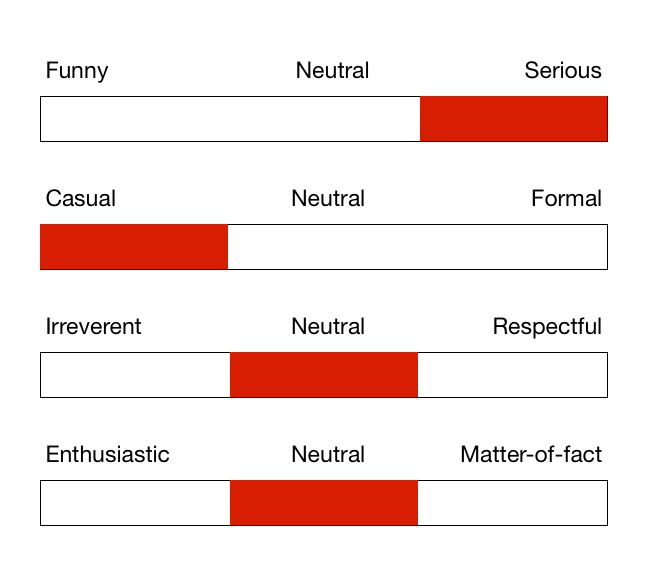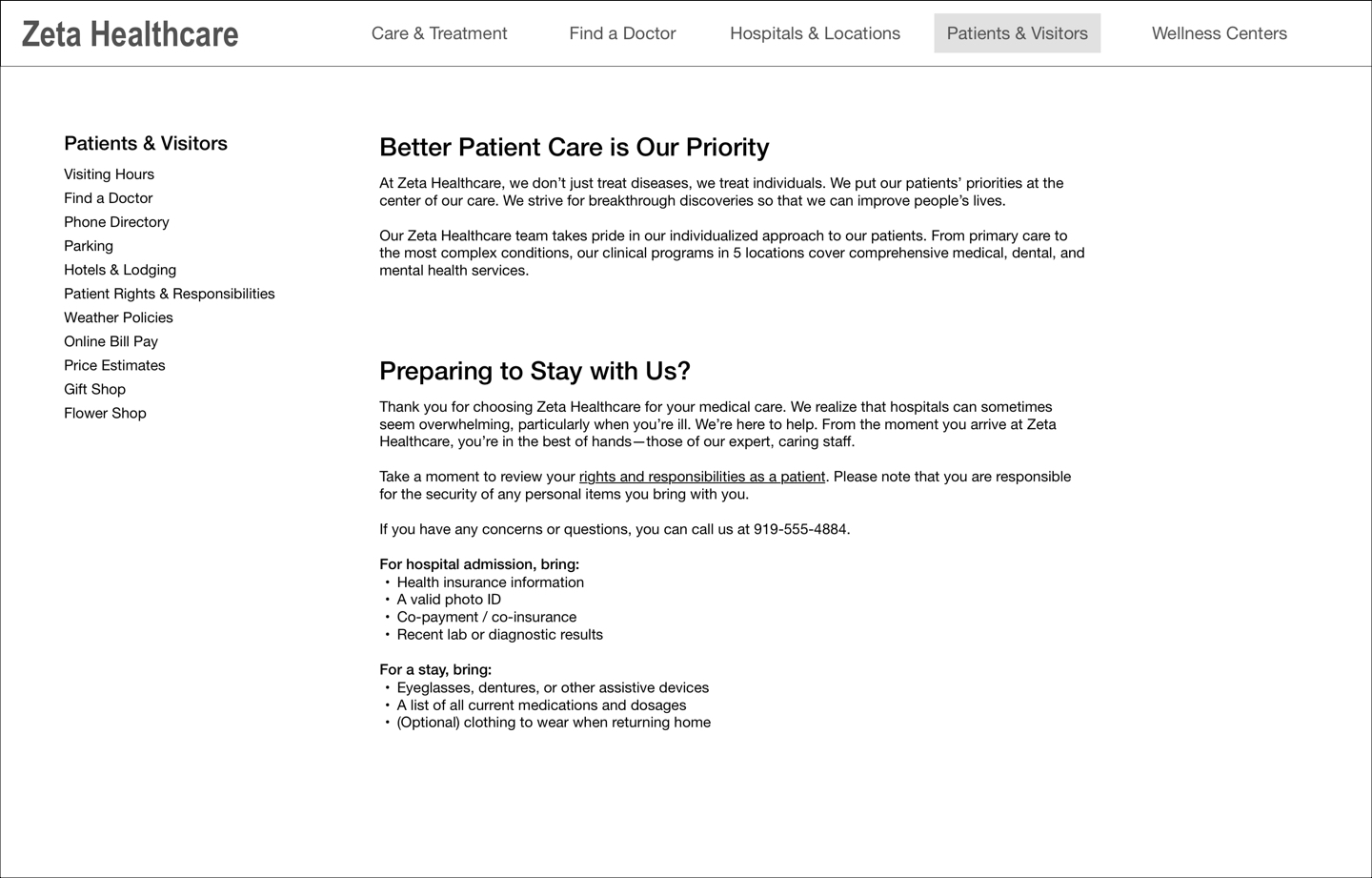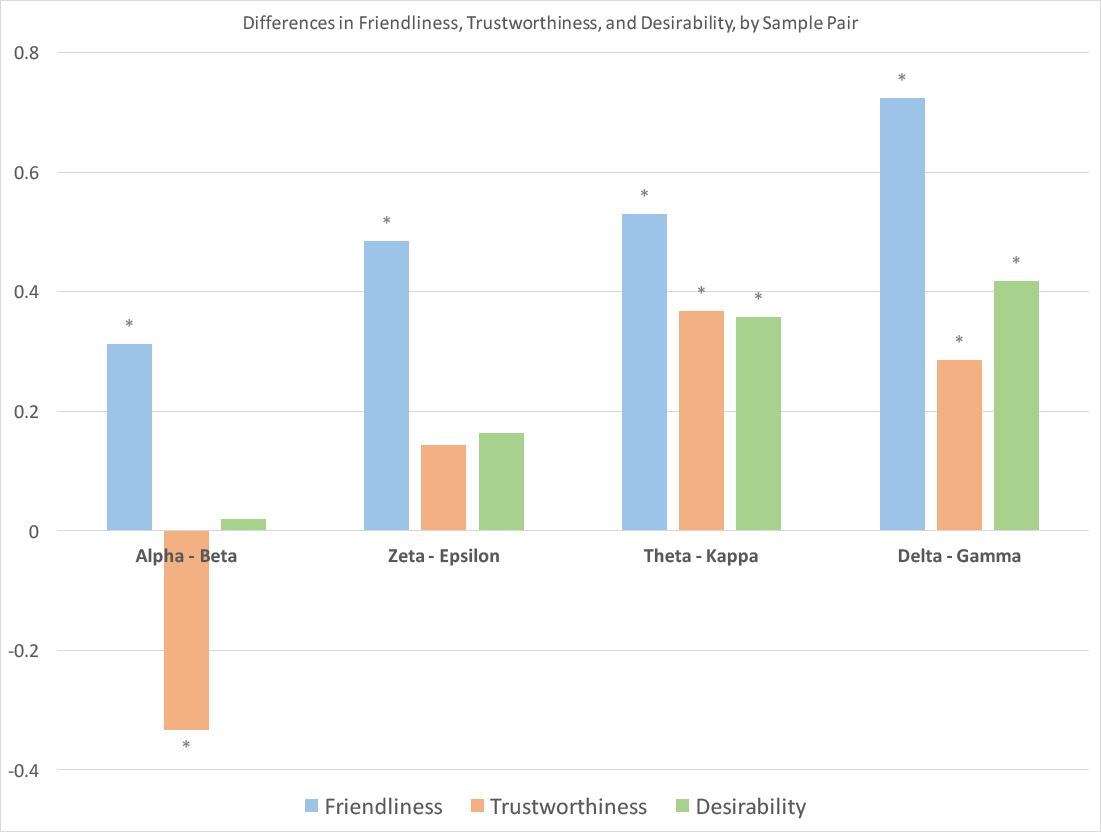As web content professionals, we know that how we communicate with our users is just as important as what we’re communicating. But often, it’s difficult to predict and demonstrate exactly how our tone of voice might affect our users.
In a two-part study, we tested pairs of nearly identical website content. In each pair, the only aspect that we varied was the tone of voice used. We found that there are indeed measurable effects of tone of voice on users, specifically on users’ impressions of an organization’s friendliness, trustworthiness, and desirability. We also found that a user’s impression of an organization’s trustworthiness is a strong predictor of their willingness to recommend that brand.
The Tone of Voice Samples
We began by identifying 4 core dimensions of tone of voice. Each dimension can be thought of as a 3-point scale, with a neutral midpoint. They can be used to create comparable tone profiles for content. Tones could fall at either extreme of each dimension, or somewhere in between:
- Funny vs. serious
- Formal vs. casual
- Respectful vs. irreverent
- Enthusiastic vs. matter-of-fact

We used those 4 dimensions to design 4 pairs of tone-of-voice samples, with 8 samples in total.
Each pair of samples was nearly identical — the same presentation, topic, context, and details. The only things we varied between the pairs was the tone and the name of the fake organization. The pairs were:
- Two landing pages for fake insurance companies, highlighting the features of their auto-insurance services and encouraging users to get a quote online
- Two patient-care pages for fake hospitals, explaining the importance of their high-quality care
- Two landing pages for fake banks, listing the benefits of their personal checking accounts
- Two homepages for fake home-security systems, providing an overview of their available services
Each tone sample was written as realistically as possible. The language used came from real-life websites, but was adapted to remove any extraneous differences that could become confounding variables. For example, both of the bank pages had to have identical APY rates, because if one had a better rate than the other to prevent participants from responding more favorably to that detail, rather than the tone.
We designed the samples to create a variety of tone profiles, described in the following table.
|
Pair |
Tone profile |
Copy example |
|
|
Auto insurance |
Alpha |
Funny, |
“You’ll find that our ALPHA car insurance customers are a happy bunch. With our world-class service and speedy claims process, who can blame them?” |
|
Beta |
Serious, |
“Your lifestyle, driving habits, and policy management preferences are just a few of the many factors considered when determining which discounts are available to you.” |
|
|
Checking account |
Delta |
Serious, casual |
“Everything you need and want from a bank: online and mobile banking services, a debit MasterCard, and standard checks. And those are just a few of the features included at no charge.” |
|
Gamma |
Serious, formal, matter-of-fact |
“Open an account today to get multiple interest-bearing accounts and complimentary and discounted services.” |
|
|
Security system |
Theta |
Funny, casual, irreverent, enthusiastic |
“A Theta Security sign in your front yard tells criminals, ‘Don’t even think about it.’” |
|
Kappa |
Serious, respectful, matter-of-fact |
“Make home feel safe again. We’re passionate about protecting your world.” |
|
|
Hospital |
Epsilon |
Serious, formal, respectful, matter-of-fact |
“For over four decades, Epsilon Health has met the health care needs of the local community. Juxtaposed with clinical excellence and cutting-edge research, Epsilon takes pride in innovative treatments.” |
|
Zeta |
Serious, casual, respectful, enthusiastic |
“At Zeta Healthcare, we don’t just treat diseases, we treat individuals. We put our patients’ priorities at the center of our care.” |
Table 1: We designed four pairs of tone-of-voice samples. Each pair was nearly identical except for the tone-of-voice profile.
The tone pairs were developed based on real-life content from actual web pages. We examined the tones of those real-life pages, and then combined excerpts from the real copy to create the fictional tone samples.
We used a manipulation check to verify that the variations in tone between the two samples in a pair were perceptible and aligned with our definitions. We surveyed 50 Americans aged 18 or older. They answered 2 Likert-rating-scales questions for each tone sample, indicating their agreement with the following two statements:
- “The website is friendly.”
- “The website is formal.”
The results are discussed in more detail in our article on the dimensions of tone of voice and strongly confirmed that the tonal qualities of each pair were perceived as different.
Methodology
Our study had two primary phases.
- Qualitative in-person user testing
- Quantitative online survey, using UserZoom and Amazon’s Mechanical Turk
We should pause here and acknowledge the very real challenges of evaluating writing through user research. Many users are prone to make comments related to aspects of visual design or information architecture, but aren’t inclined to think about the writing. To eliminate potential distractions, we presented the tone samples in two stripped-down formats: simple wireframes for the qualitative phase, and text excerpts for the quantitative phase.


During the qualitative testing, we gave users scenarios (e.g. “Imagine your friend is preparing for minor surgery. You’ve offered to help your friend decide which hospital to visit for the surgery.”) and showed them the wireframes. We asked them to think aloud and share their thoughts on the wireframes.
In the quantitative survey of 100 American users over the age of 18, we asked the respondents to rate each sample on three 5-point Likert scales. In each scale, we asked the respondents to indicate their impressions of the organization itself, not their impressions of the writing. We were interested in measuring respondents’ perceptions of the brand’s:
- Friendliness
- Trustworthiness
- Desirability (whether they would recommend the product or service to a friend)
We selected these three factors as the most important aspects of users’ impressions that we expected to be influenced by the tone of voice used in the writing. Of these three, desirability is the most important: a user’s indication of willingness to recommend a brand is a strong predictor of the success of that brand (which is partially why the Net Promoter Score, NPS, is so popular). Desirability is derived subjectively by each customer from those product and service qualities that we do have the ability to design, such as the tone-of-voice manipulations in this study.
Key Takeaways
Tone of voice has measurable qualities and measurable impact on users.
There will always be subtle differences in individual interpretations of tone. What sounds “witty” to one person will sound “corny” to another. But our findings suggest that:
- there are quantifiable qualities of tone (like friendliness and formality);
- those aspects have measurable impacts on user’s impressions of brand personality (like the friendliness and trustworthiness of the brand); and
- those impressions significantly influence users’ willingness to recommend a brand.
Measurements of desirability (like NPS) are critical to brand success, and can be very difficult to improve — but these results show that the tone of your content can influence that desirability.

The asterisks by the bars indicate which differences are significant at p < 0.05.
Trust and credibility are essential.
A multiple regression analysis of our survey data with friendliness and trustworthiness as the independent variables showed that both factors were statistically significant predictors of desirability (willingness to recommend). However, trustworthiness is a much stronger predictor of desirability, across all the industries.
On average, 52% of the variability in the desirability scores is explained by trustworthiness. Friendliness only explains an extra 8% of the variability in the desirability scores when we add it to the regression analysis. This confirms what we would expect — that users’ perceptions of trustworthiness are critical to their decisions whether or not to interact with an organization (make a purchase, use a service, etc.) But it is surprising that trustworthiness may be so much more important than friendliness. Tone of voice is a powerful tool for influencing that perception of trustworthiness, and the right tone to evoke trust will differ based on your users and their concerns. Make sure you convey a sense of trust in all aspects of your site.
A playful tone won’t work well for everyone.
Participants in both phases of the study agreed that Alpha (the auto-insurance sample whose tone profile was playful and informal – see Table 1) was friendlier than the more serious sample, Beta. (In the online survey, Alpha was rated as friendlier by a difference of 0.3 points ± 0.2 on a 5-point scale.) Despite this, respondents were no more likely to recommend Alpha, and actually rated Beta as more trustworthy than Alpha by 0.3 points.
A playful tone for a serious industry has the potential of creating pleasant surprise and helping a company stand out from its competitors. However, in this situation, the friendliness and irreverence actually undermined users’ perceptions of trustworthiness and professionalism.
People don’t expect car insurance to be fun, and this particular humorous tone came on too strong for the topic. “The speech is too chummy,” one participant pointed out. “The friendliness kind of takes away some of the credibility.”
If you’re frequently hearing feedback from your stakeholders like, “Make it exciting!” or “Add a joke,” bear this example in mind. An exciting, chummy, or funny tone of voice won’t be ideal for all organizations.
Even traditionally dry industries like finance can benefit from a little conversational language.
Serious doesn’t necessarily have to be cold and formal. In the quantitative phase of the study, the more casual bank, Delta, was perceived as friendlier (0.7 points ± 0.2 on a 5-point scale) and more trustworthy (0.3 ± 0.1) than its serious counterpart Gamma. Respondents were more likely to recommend Delta to a friend (0.4 ± 0.2).
Participants in the qualitative phase described Delta as “approachable” and “straightforward,” and described Gamma as “dull” and “intimidating.”
Don’t let a humorous tone get in the way of actually communicating with your users.
In the online survey, respondents rated the humorous tone of the home-security site Theta as friendlier (0.5 points ± 0.2 on a 5-point scale) and more trustworthy (0.4 ± 0.1) than Kappa’s. Respondents were also more likely to recommend Theta to a friend (0.4 ± 0.2).
One participant in the qualitative phase enjoyed the humor in Theta, and found Kappa to be too heavy. “’Make Home Feel Safe Again,’” she read. “Like it wasn’t safe before?” But three other participants really disliked Theta. One participant said she found the humorous headlines to be “corny,” and another said, “They need to get more to the point.”
This tone-sample pair illustrates the fact that humor can be a powerful way of differentiating you from your competitors — as long as your users actually find it funny. Humor is extremely risky, because when it fails, you annoy and alienate your users.
In particular, don’t let your attempts at humor get in the way of actually communicating to users the information they need to know. Theta used headlines like “Where there’s smoke, there’s us” (a verbatim headline from a real home-security website). Funny or clever headlines often fail to serve the actual purpose of headlines — letting users know what information is located below the headline.
Consider the emotional needs of your users when choosing a tone.
In the qualitative study, the more casual and enthusiastic hospital, Zeta, was perceived as friendlier than Epsilon (a difference of 0.5 points ± 0.2 points on a 5-point scale), and marginally more trustworthy than Epsilon (p=0.05). In the qualitative phase, users unanimously preferred Zeta over Epsilon.
In this scenario, Zeta’s friendliness without an attempt at humor seemed to reassure users during a potentially stressful situation. One participant in the qualitative study compared the difference between Zeta and Epsilon to the difference between a doctor and a nurse. She described Epsilon as “businesslike,” and said that in her experience “nurses have more of a bedside manner.”
Remember to consider the concerns of your readers and their emotional state when choosing a tone. If your users are nervous patients preparing for surgery, do you really think they’d prefer a formal tone? If your users are arriving frustrated at an error page, do you really think they want that error message to be a joke?
The best tone for your content will depend on your users, your message, and your brand.
Across all of the tone samples tested, we saw that casual, conversational, and moderately enthusiastic tones performed best, though they do not necessarily need to be combined. As we saw with Delta and Gamma, a conversational but serious tone can be successful for a bank.
Choosing a tone of voice is a tricky game of balancing your brand’s personality and priorities. There’s no one solution for every situation. As we saw with Alpha and Beta, it’s possible to choose a tone that makes your brand seem friendly, but still doesn’t make your potential customers more likely to choose you.
The best way to know what will work for you is to evaluate your tone of voice with your users.
Tips for Evaluating Your Tone of Voice
Your users’ context is hugely important, and it’s not always easy to predict. You might think people respond to a grandiose and professional tone for a hospital, because it inspires confidence. But many participants found that a light, conversational tone conveyed empathy, which was meaningful to them. Remember, you are not your user. Your predictions of how your users will react to your tone may be off. As much as possible, test with representative users to help you evaluate your expectations.
Interpretation of tone is intensely personal and individual. You'll always have a few people that hate or love a tone unexpectedly, but you have to listen to the comments to understand overall themes across many participants.
Since there is substantial nuance in the tone-of-voice interpretations (and users’ associated preferences), we recommend that you don’t rely solely on quantitative metrics like the ones we've discussed here.
Quantitative data is useful for measuring whether users can perceive your intended tone, and comparing such numbers between alternate proposed pieces of writing. Qualitative research is much better for understanding why users like certain forms of communication, as well as getting deeper insights into how they interpret your content. For these insights, be sure to conduct qualitative user studies where customers will say something about your content, not just score it.
If you find that your users are frequently commenting on the visual design, interaction design, or features of your UI when you want them to comment on tone, you have to be patient. You shouldn’t just direct your users to talk about the tone of voice, because you’ll risk biasing them.
To encourage user comments about the tone of voice:
- Try eliminating distractions by creating wireframes or simple text excerpts of your content (as we did for this experiment).
- Ask your users prompting but vague questions, such as “If this website were a person, who would it be? Why?,” to get them thinking about the personality of the writing.
- Try a modified product-reaction test, by asking your users to select descriptions from a list of tone words.
Conclusion
Tone of voice is a complicated and nuanced aspect of your digital copy. However, as this study shows, the impacts of tone on brand perception are significant enough to merit your attention. Tone of voice can and should be tested, just like other pieces of the user experience.
(More on tone of voice in our digital content strategy courses. More on trustworthiness in the Persuasive Web Design course.)





Share this article: